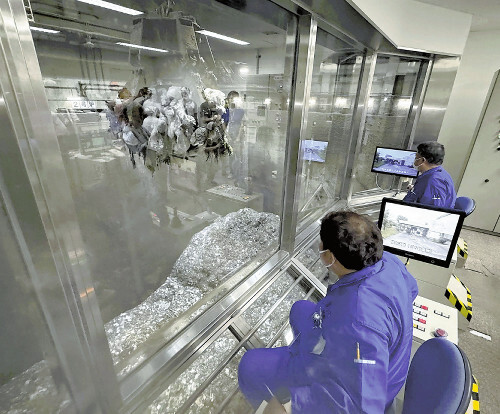
When you buy through links on our articles, Future and its syndication partners may earn a commission.

Two bright meteors were caught slamming into the moon on Thursday (Oct. 30) and Saturday (Nov. 1), by Japanese astronomer Daichi Fujii, curator of the Hiratsuka City Museum. The flashes, visible from Earth for just a split second, were caused by space rocks striking the lunar surface at high speed, producing brief but brilliant explosions of light.
As the Southern Taurid meteor shower approaches its peak around Nov. 5 and the Northern Taurids follow on Nov. 9, meteors are already lighting up Earth's skies — and apparently that of the moon as well. Fujii recorded the impacts using cameras aimed at the moon's nightside, sharing the dramatic videos on his X account.
The first collision occurred at 8:30 p.m. Japan Standard Time (6:30 a.m. EST or 1130 GMT) on Oct. 30, while the second happened at 8:49 p.m. Japan Standard Time (6:49 a.m. EDT or 1149 GMT) on Nov. 1.
According to Fujii, the Oct. 30 flash appeared east of the Gassendi Crater. Based on his calculations, the impactor was likely part of the Taurid meteor stream, striking the moon at a velocity of 27 km/s (60,000 mph) and an angle of 35 degrees. The meteoroid's estimated mass was 0.4 pounds (0.2 kilograms), excavating a crater about 10 feet (3 meters) wide and producing a flash lasting just 0.1 seconds.
"The pixels were saturated, so it's possible the flash was even brighter than the recorded data suggests", Fujii told Space.com.
The second flash, on Nov.1, appeared west of Oceanus Procellarum, one of the moon's largest lunar maria.
While it's not yet confirmed whether these impacts originated from the Taurids or were simply sporadic meteors, Fujii notes the timing aligns with the showers' period of increased activity. This marks the latest in a series of lunar impact observations by Fujii, who has become one of the leading recorders of such events.

"I started observing lunar impact flashes around 2011 and have been continuously observing since 2020," Fujii said. "With my 20cm telescope, I typically detect about one impact flash every few dozen hours of observation. Because the thin crescent moon is visible only briefly and often low in the sky where thin clouds are common, I only observe a few dozen flashes per year".
Fujii has documented a total of 60 flashes so far.
Unlike Earth, which is shielded by a thick atmosphere that vaporizes most meteors before they reach the ground, the moon's virtually non-existent atmosphere means there is nothing to slow down incoming meteors, sending them crashing into its surface at speeds of 45,000 to 160,000 mph (20 to 72 km/s) — releasing powerful bursts of light and heat on impact.
Such impacts can excavate craters tens of feet across, even from meteoroids weighing just a few pounds. For example, a rock just 11 pounds (5 kilograms) in mass can gouge a crater more than 30 feet (9 meters) wide and eject over 75 metric tons of lunar soil and rock, according to NASA.
 Very good quality Greens All over The Planet
Very good quality Greens All over The Planet 仙台育英高校サッカー部がいじめ問題で全国大会出場を辞退。弁護士の見解や代替出場の可能性は? #エキスパートトピ(下薗昌記) - エキスパート - Yahoo!ニュース
仙台育英高校サッカー部がいじめ問題で全国大会出場を辞退。弁護士の見解や代替出場の可能性は? #エキスパートトピ(下薗昌記) - エキスパート - Yahoo!ニュース 来年の大河「豊臣兄弟!」語りは安藤サクラに決定「新鮮でとても楽しみ」…朝ドラ「まんぷく」チーフ演出と再タッグに感激(スポーツ報知)
来年の大河「豊臣兄弟!」語りは安藤サクラに決定「新鮮でとても楽しみ」…朝ドラ「まんぷく」チーフ演出と再タッグに感激(スポーツ報知) 全国的な「クマ禍」の影響はスポーツ界にも。サッカー、駅伝、野球、ゴルフ、様々な競技にその余波が #エキスパートトピ(下薗昌記) - エキスパート - Yahoo!ニュース
全国的な「クマ禍」の影響はスポーツ界にも。サッカー、駅伝、野球、ゴルフ、様々な競技にその余波が #エキスパートトピ(下薗昌記) - エキスパート - Yahoo!ニュース 「なかなか行けない場所」ツアー人気…清掃工場の操作室・空港の制限区域・銭湯の裏側などに「発見」求め(読売新聞オンライン)
「なかなか行けない場所」ツアー人気…清掃工場の操作室・空港の制限区域・銭湯の裏側などに「発見」求め(読売新聞オンライン) トヨタ、新型「ハイラックス」タイで世界初公開=9代目はBEV設定 日本は26年導入へ(くるまのニュース)
トヨタ、新型「ハイラックス」タイで世界初公開=9代目はBEV設定 日本は26年導入へ(くるまのニュース) Vietnam rethinks its flood strategy as climate change drives storms and devastation
Vietnam rethinks its flood strategy as climate change drives storms and devastation Unwind: Four Extraordinary Spa Resorts On the planet
Unwind: Four Extraordinary Spa Resorts On the planet Number_i、新曲の “差別表現” が物議…「ポカホンタス」安易な使用に専門家は「注意が必要」と指摘、TOBEの回答は?(SmartFLASH)
Number_i、新曲の “差別表現” が物議…「ポカホンタス」安易な使用に専門家は「注意が必要」と指摘、TOBEの回答は?(SmartFLASH)













